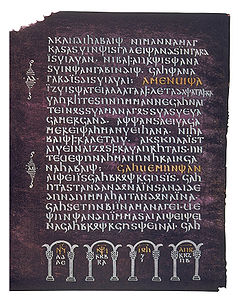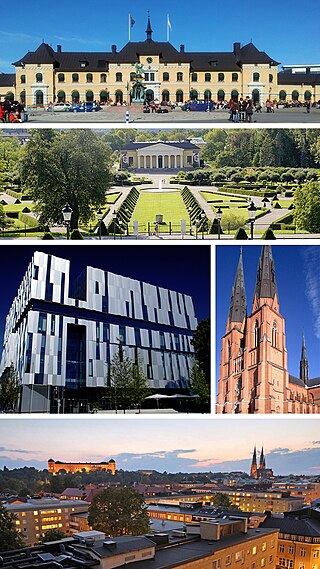
Uppsala is the county seat of Uppsala County and the fourth-largest city in Sweden, after Stockholm, Gothenburg, and Malmö. It had 177,074 inhabitants in 2019.

Uppsala University (UU) is a public research university in Uppsala, Sweden. Founded in 1477, it is the oldest university in Sweden and the Nordic countries still in operation.

The Codex Argenteus is a 6th-century illuminated manuscript, originally containing part of the 4th-century translation of the Christian Bible into the Gothic language. Traditionally ascribed to the Arian bishop Wulfila, it is now established that the Gothic translation was performed by several scholars, possibly under Wulfila's supervision. Of the original 336 folios, 188—including the Speyer fragment discovered in 1970—have been preserved, containing the translation of the greater part of the four canonical gospels. A part of it is on permanent display at the Carolina Rediviva building in Uppsala, Sweden, under the name "Silverbibeln".
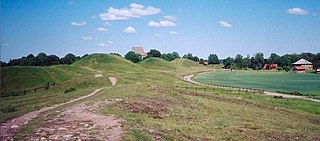
Gamla Uppsala is a parish and a village outside Uppsala in Sweden. It had 17,973 inhabitants in 2016.

The National Library of Sweden is Sweden's national library. It collects and preserves all domestic printed and audio-visual materials in Swedish, as well as content with Swedish association published abroad. Being a research library, it also has major collections of literature in other languages.

Uppsala Cathedral is a cathedral located between the University Hall of Uppsala University and the Fyris river in the centre of Uppsala, Sweden. A church of the Church of Sweden, the national church, in the Lutheran tradition, Uppsala Cathedral is the seat of the Archbishop of Uppsala, the primate of Sweden. It is also the burial site of King Eric IX, who became the patron saint of the nation, and it was the traditional location for the coronation of new Kings of Sweden.
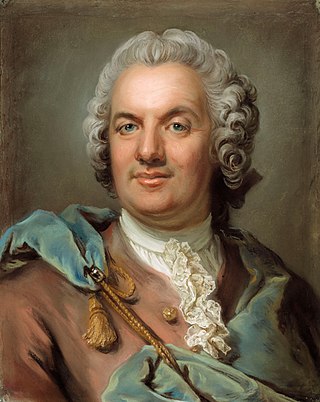
Johan Ihre was a Swedish philologist and historical linguist.
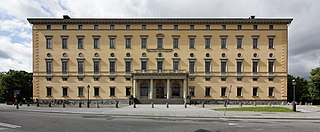
The Uppsala University Library at Uppsala University in Uppsala, Sweden, consists of 11 subject libraries, one of which is housed in the old main library building, Carolina Rediviva. The library holds books and periodicals, manuscripts, musical scores, pictures, and maps.
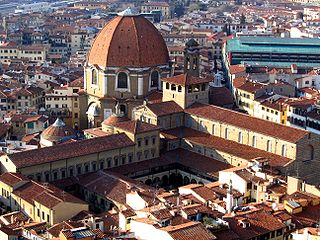
The Laurentian Library is a historic library in Florence, Italy, containing more than 11,000 manuscripts and 4,500 early printed books. Built in a cloister of the Medicean Basilica di San Lorenzo di Firenze under the patronage of the Medici pope Clement VII, the library was built to emphasize that the Medici were no longer just merchants but members of intelligent and ecclesiastical society. It contains the manuscripts and books belonging to the private library of the Medici family. The library building is renowned for its architecture that was designed by Michelangelo and is an example of Mannerism.
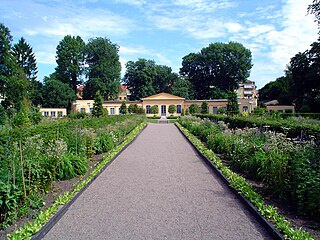
The Linnaean Garden or Linnaeus Garden is the oldest of the botanical gardens belonging to Uppsala University, Sweden, and nowadays one of two satellite gardens of the larger University of Uppsala Botanic Garden, the other being the Linnaeus family's former summer home Linnaeus's Hammarby. The garden has been restored and is kept as an 18th-century botanical garden, according to the specifications of Carl Linnaeus, who started studying at Uppsala University in 1730 where he later became professor of botany and principal and is known for formalising the modern system of naming organisms, creating the modern binomial nomenclature, and who owned the garden from 1741 and had it rearranged according to his own ideas, documented in his work Hortus Upsaliensis (1748).

Peter Elof Herman Torsten Folke von Celsing was a Swedish modernist architect.

Gustavianum is the oldest standing building of Uppsala University. It was built between 1622 and 1625, and was used as the main building of the university between 1778 and 1887. Since 1997, it has been used as the university's museum.
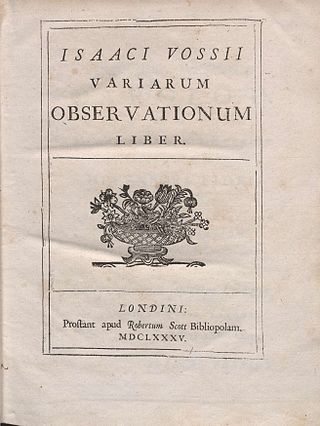
Isaak Vossius, sometimes anglicised Isaac Voss was a Dutch philologist scholar and manuscript collector.

The National Archives of Sweden is the official archive of the Swedish government and is responsible for the management of records from Sweden's public authorities. Although the archives functions primarily as the government archive, it also preserves some documents from private individuals and non-public organizations. The mission of the archives is to collect and preserve records for future generations.

Anders Uppström was a Swedish philologist, particularly known for his work on the Codex Argenteus, the manuscript of Bishop Wulfila's Gothic Bible translation held by the Uppsala University Library.

Härkeberga Church is a Lutheran church in the Archdiocese of Uppsala in Uppsala County, Sweden. It contains a number of well-preserved 15th-century frescos attributed to Albertus Pictor.

The Archbishop's Palace in Uppsala, Sweden, is the official residence of the Lutheran Archbishop of Uppsala, the primate of the Church of Sweden. It was designed by Carl Hårleman and first completed in 1744, on or close to the site of several earlier buildings previously serving a similar role. The palace is situated facing the University Park, close to Uppsala Cathedral in the old city centre, west of the river.

University Hall or the University Main Building is the main building of Uppsala University in Uppsala, Sweden. The building is situated in University Park close to Uppsala Cathedral. It was designed in Italian renaissance Beaux-Arts style by architect Herman Teodor Holmgren (1842-1914) and completed in 1887.
The following is a timeline of the History of Uppsala.
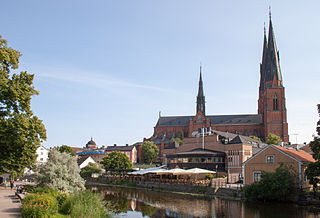
Fjärdingen is a neighbourhood in the inner city of Uppsala, Sweden, situated on the western banks of the river Fyris. It has been the ecclesiastical centre of Sweden since the 13th century and contains many of the historical sights and landmarks of Uppsala, notably Uppsala Cathedral on the Domberget hill, with the Archbishop's residence and Church of Sweden offices, as well as the historical university district of Sweden's oldest university, Uppsala University. Notable university buildings in the area include University Hall, Gustavianum and Carolina Rediviva, as well as most of the student nation buildings. To the south, Uppsala Castle, the University Hospital and the Stadsträdgården city park form the boundary of the historical inner city.

